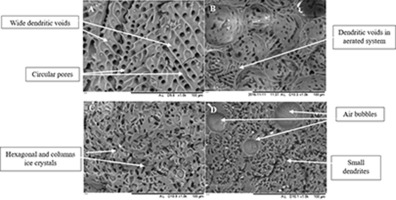当前位置:
X-MOL 学术
›
Food Hydrocoll.
›
论文详情
Our official English website, www.x-mol.net, welcomes your feedback! (Note: you will need to create a separate account there.)
Effect of freezing on microstructure and reconstitution of freeze-dried high solid systems
Food Hydrocolloids ( IF 10.7 ) Pub Date : 2018-10-01 , DOI: 10.1016/j.foodhyd.2018.05.008 N. Malik , O. Gouseti , S. Bakalis
Food Hydrocolloids ( IF 10.7 ) Pub Date : 2018-10-01 , DOI: 10.1016/j.foodhyd.2018.05.008 N. Malik , O. Gouseti , S. Bakalis

|
Abstract Freeze-drying has been associated with high quality hydrocolloid-based products such as coffee. However, it is an expensive technique, and one way to reduce energy and water use is by drying concentrated systems. Controlling the ice crystal formation is important to produce final dried materials with desired microstructure and properties. This study presents the effect of freezing with and without temperature oscillations on the final microstructure and reconstitution of aerated and non-aerated freeze-dried concentrated (50 and 60% w/w) gum arabic and coffee systems. Samples were either frozen at -40 °C or subjected to fluctuating temperatures between -40 and -20 °C prior to drying. Thermal analysis of the systems showed lower nucleation and freezing temperatures for 50% compared to 60% solutions, as expected, and melting temperatures > -20 °C. During drying, puffing of the material was observed, with appearance of a glass-like, puffed bottom layer, in particular for the 60% coffee frozen at -40 °C. SEM micrographs revealed pores of dendritic, hexagonal, and circular shape, indicating voids produced by sublimation of ice crystals. Pore sizes were smaller (by 50%, of the order of 40im) for the 60%, than the 50% systems. Temperature fluctuations during freezing doubled the observed pore sizes and the apparent total porosity which effectively accelerated the dissolution kinetics. Aeration resulted in the appearance of air bubbles (diameter 200–1600 μm) that largely phase separated in gum arabic and resulted in faster rehydrating solids. This work demonstrates the potential of process design to control microstructural attributes and reconstitution properties of freeze-dried hydrocolloid-based products in systems with high solute concentrations.
中文翻译:

冷冻对冻干高固体系微观结构和重构的影响
摘要 冷冻干燥与高质量的水胶体产品如咖啡有关。然而,这是一项昂贵的技术,减少能源和水使用的一种方法是干燥浓缩系统。控制冰晶的形成对于生产具有所需微观结构和性能的最终干燥材料很重要。本研究展示了在有和没有温度波动的情况下冷冻对充气和非充气冷冻干燥浓缩(50% 和 60% w/w)阿拉伯树胶和咖啡系统的最终微观结构和重构的影响。在干燥之前,样品要么在 -40 °C 下冷冻,要么在 -40 到 -20 °C 之间波动温度。系统的热分析表明,与 60% 的溶液相比,50% 的成核和冻结温度更低,正如预期的那样,熔化温度 > -20°C。在干燥过程中,观察到材料膨化,出现玻璃状膨化底层,尤其是在 -40°C 下冷冻的 60% 咖啡。SEM 显微照片显示出树枝状、六边形和圆形的孔隙,表明冰晶升华产生的空隙。60% 的孔径比 50% 的系统小(小 50%,大约 40 微米)。冷冻过程中的温度波动使观察到的孔径和表观总孔隙率加倍,这有效地加速了溶解动力学。曝气导致气泡(直径 200-1600 微米)的出现,这些气泡在阿拉伯树胶中主要发生相分离,并导致更快的固体再水化。
更新日期:2018-10-01
中文翻译:

冷冻对冻干高固体系微观结构和重构的影响
摘要 冷冻干燥与高质量的水胶体产品如咖啡有关。然而,这是一项昂贵的技术,减少能源和水使用的一种方法是干燥浓缩系统。控制冰晶的形成对于生产具有所需微观结构和性能的最终干燥材料很重要。本研究展示了在有和没有温度波动的情况下冷冻对充气和非充气冷冻干燥浓缩(50% 和 60% w/w)阿拉伯树胶和咖啡系统的最终微观结构和重构的影响。在干燥之前,样品要么在 -40 °C 下冷冻,要么在 -40 到 -20 °C 之间波动温度。系统的热分析表明,与 60% 的溶液相比,50% 的成核和冻结温度更低,正如预期的那样,熔化温度 > -20°C。在干燥过程中,观察到材料膨化,出现玻璃状膨化底层,尤其是在 -40°C 下冷冻的 60% 咖啡。SEM 显微照片显示出树枝状、六边形和圆形的孔隙,表明冰晶升华产生的空隙。60% 的孔径比 50% 的系统小(小 50%,大约 40 微米)。冷冻过程中的温度波动使观察到的孔径和表观总孔隙率加倍,这有效地加速了溶解动力学。曝气导致气泡(直径 200-1600 微米)的出现,这些气泡在阿拉伯树胶中主要发生相分离,并导致更快的固体再水化。



























 京公网安备 11010802027423号
京公网安备 11010802027423号